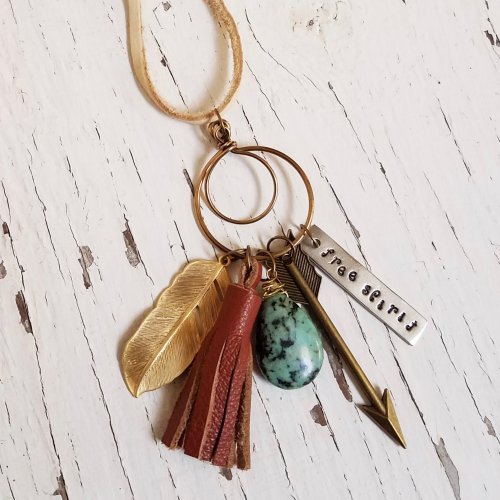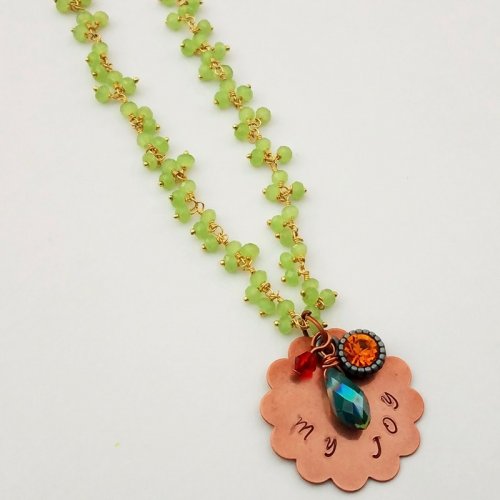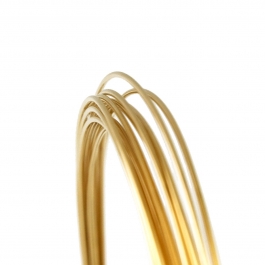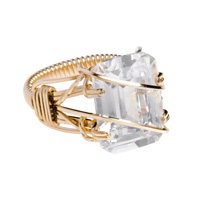Sell or Display Valued Stones
Question:
Dale, I just love the series of articles on gemstones; it's such a huge field of study one hardly knows where to start. Thank you! My question is about pricing for rarity.
You made a comment about Ocean Jasper that literally made me gasp! If Ocean Jasper is not being actively mined at the original source anymore, I'm reluctant to part with what I think are exceptional examples. My experience is that good specimens of Ocean Jasper are not that easy to come by (at least within the limited travel I do). I'm torn between starting a private collection of "not for sale" stones, and trying to decide what a fair price is for stones that truly stand out above the rest. It's a fact that stones are one-of-a-kind, but as an artist, I put a higher value on visual impact. I might buy a whole strand because of one or two stones. I'm a bit timid about saying, "This stone is worth much more," and then pricing accordingly. Help! Your encouragement and suggestions are always right on target.
-Marcia in Syracuse, New York
Dale, I just love the series of articles on gemstones; it's such a huge field of study one hardly knows where to start. Thank you! My question is about pricing for rarity.
You made a comment about Ocean Jasper that literally made me gasp! If Ocean Jasper is not being actively mined at the original source anymore, I'm reluctant to part with what I think are exceptional examples. My experience is that good specimens of Ocean Jasper are not that easy to come by (at least within the limited travel I do). I'm torn between starting a private collection of "not for sale" stones, and trying to decide what a fair price is for stones that truly stand out above the rest. It's a fact that stones are one-of-a-kind, but as an artist, I put a higher value on visual impact. I might buy a whole strand because of one or two stones. I'm a bit timid about saying, "This stone is worth much more," and then pricing accordingly. Help! Your encouragement and suggestions are always right on target.
-Marcia in Syracuse, New York
Instructions
Answer:
Thanks Marcia! Yes, deciding how to proceed with the Gem Profiles was a bit confusing for me at first, but when I decided not to worry about the word "gem" and to just write about the rocks and minerals that we most often use in our wire jewelry designs, it became fun! (And it is helping me sort through the many piles of rocks in and around my studio, too!)
With regards to your question about rarity and pricing brought up by ocean jasper, well, I always tell my students that very special pieces deserve very special prices! As artists, usually when a special stone or cabochon catches our eye we have a definite idea of what we want to use it for. More often than not, the piece comes home with us and ends up in a special drawer, waiting for that day (and if you are like me, you find it again... years later!). Speaking from personal experience and choices, if and when I decide to use a very special piece or two in a jewelry design, I don't worry about the price of materials, I just make what feels "right" (meaning that sometimes a stone screams to be set in 14 or 18kt solid gold). When the piece is done, I don't worry about selling it, either! I believe that every piece has an owner (even though it may take years for them to find one another). This "show-stopper" becomes a centerpiece in my display cases at art shows, and it may spend a few months in one gallery or another, as an example of what I am able to create. Because of the attention it attracts, it often adds to my sales via customer orders (and I love wearing things like this to special events!)
With regard to pricing something like this, for example if the materials cost $300 wholesale, and I spent a week or so working on it, then my price could be from $1800 to $2500 or more. If it sells, fine. If not, that's fine too! The photo below is one such piece. "Dancing Stones" is made entirely in Argentium® silver and with the exception of the 4mm lab-grown ruby, all of the rest are AA grade natural stones (rubile tourmaline, peridot, chrome diopside, blue topaz, iolite, orange topaz, citrine, and 2 rainbow moonstone/white labradorite cabs custom cut by my husband just for this piece); as metal prices rise, so does its price. (On average, I sell one piece every six months for between $1200 and $1800.)
Thanks Marcia! Yes, deciding how to proceed with the Gem Profiles was a bit confusing for me at first, but when I decided not to worry about the word "gem" and to just write about the rocks and minerals that we most often use in our wire jewelry designs, it became fun! (And it is helping me sort through the many piles of rocks in and around my studio, too!)
With regards to your question about rarity and pricing brought up by ocean jasper, well, I always tell my students that very special pieces deserve very special prices! As artists, usually when a special stone or cabochon catches our eye we have a definite idea of what we want to use it for. More often than not, the piece comes home with us and ends up in a special drawer, waiting for that day (and if you are like me, you find it again... years later!). Speaking from personal experience and choices, if and when I decide to use a very special piece or two in a jewelry design, I don't worry about the price of materials, I just make what feels "right" (meaning that sometimes a stone screams to be set in 14 or 18kt solid gold). When the piece is done, I don't worry about selling it, either! I believe that every piece has an owner (even though it may take years for them to find one another). This "show-stopper" becomes a centerpiece in my display cases at art shows, and it may spend a few months in one gallery or another, as an example of what I am able to create. Because of the attention it attracts, it often adds to my sales via customer orders (and I love wearing things like this to special events!)
With regard to pricing something like this, for example if the materials cost $300 wholesale, and I spent a week or so working on it, then my price could be from $1800 to $2500 or more. If it sells, fine. If not, that's fine too! The photo below is one such piece. "Dancing Stones" is made entirely in Argentium® silver and with the exception of the 4mm lab-grown ruby, all of the rest are AA grade natural stones (rubile tourmaline, peridot, chrome diopside, blue topaz, iolite, orange topaz, citrine, and 2 rainbow moonstone/white labradorite cabs custom cut by my husband just for this piece); as metal prices rise, so does its price. (On average, I sell one piece every six months for between $1200 and $1800.)

Now the second part of your question, do you use and sell special stones or form a collection? Well, most of us already have such collections, waiting to be used. Why not label them and put them in a Riker case? This way you can enjoy looking at them while you work - for inspiration, and you can easily take them with you to shows if you desire - maybe generating special orders, or put them in your safe when you travel.
As far as trying to explain the value of one stone over another to a customer, in my opinion, if they have to ask, you will not make the sale anyhow because they can't "see" the difference from an "art-eye." If they seem to like the stone but they want to dicker about the price, don't even take it out of the case. Simply direct them to a similar item with a price that is in their comfort zone. This is one of the reasons why I recommend putting a "show-stopper" in the middle of a case, surrounded by less expensive pieces of similar colors. The "big" one catches the eye and the smaller ones make sales, just be sure all of the price tags are showing!!
This is a good time to tell you all what some of us do with those beads we really have no use for! Karen Braverman-Freeman came to visit me in Tucson, with a special request. Karen donates her time to run jewelry making classes at Camp Summersault in Long Beach, California. This is a day camp for children with cancer and their siblings. All of the supplies are donated, such as beads, findings, and stringing materials. If you would like to donate any tax deductible materials to this very worthy cause, please contact Karen via email here. I hope my answers have met your expectations, Marcia, thanks for asking!!
As far as trying to explain the value of one stone over another to a customer, in my opinion, if they have to ask, you will not make the sale anyhow because they can't "see" the difference from an "art-eye." If they seem to like the stone but they want to dicker about the price, don't even take it out of the case. Simply direct them to a similar item with a price that is in their comfort zone. This is one of the reasons why I recommend putting a "show-stopper" in the middle of a case, surrounded by less expensive pieces of similar colors. The "big" one catches the eye and the smaller ones make sales, just be sure all of the price tags are showing!!
This is a good time to tell you all what some of us do with those beads we really have no use for! Karen Braverman-Freeman came to visit me in Tucson, with a special request. Karen donates her time to run jewelry making classes at Camp Summersault in Long Beach, California. This is a day camp for children with cancer and their siblings. All of the supplies are donated, such as beads, findings, and stringing materials. If you would like to donate any tax deductible materials to this very worthy cause, please contact Karen via email here. I hope my answers have met your expectations, Marcia, thanks for asking!!
Materials

Wire

Beads

Cabochons
Tools

Ultimate wire-pliers Set
G15-20
- G15-20
- Lesson Quantity: 1.00 pieces
- Purchase Quantity: 1.00 each
- Price: $99.95
- Gold Club Price: $74.96
- Category: General Education
- Technique(s): General Education






















 Make a Finished Ribbon Necklace
Make a Finished Ribbon Necklace Cleaning with Baking Soda
Cleaning with Baking Soda Purple Turquoise and Turquoise Facts
Purple Turquoise and Turquoise Facts Irradiated Quartz Necklace
Irradiated Quartz Necklace Removing Rust Without Damaging Tools
Removing Rust Without Damaging Tools Wire Jewelry to Make as You Sell
Wire Jewelry to Make as You Sell All About Soft Wire
All About Soft Wire Chain Lavaliere
Chain Lavaliere Wire Metal Substitutions
Wire Metal Substitutions Glue for Finishing Cords
Glue for Finishing Cords My Fingers Hurt
My Fingers Hurt Taming the Wild Wire Bundle
Taming the Wild Wire Bundle Making Matching Freeform Earrings
Making Matching Freeform Earrings What is My Wire's Circumference
What is My Wire's Circumference Testing True Ivory
Testing True Ivory Is My Coral Real
Is My Coral Real Wrapping Tiny Cabs
Wrapping Tiny Cabs Finished Leather Cord
Finished Leather Cord Prevent Scratches on Cabochons
Prevent Scratches on Cabochons Crystal Wave Ring Finishing Tips
Crystal Wave Ring Finishing Tips Purity and Sensitivity with Argentium Silver
Purity and Sensitivity with Argentium Silver Wrapping Coins for Jewelry
Wrapping Coins for Jewelry Wrapping a Large Pearl Ring
Wrapping a Large Pearl Ring Perfect Chain for Wire Jewelry
Perfect Chain for Wire Jewelry How Do I Keep Square Wire From Twisting When Wrapping
How Do I Keep Square Wire From Twisting When Wrapping Wire Temper by Number
Wire Temper by Number Will Liver of Sulfur Harm Lampwork Beads
Will Liver of Sulfur Harm Lampwork Beads Forging Copper Wire
Forging Copper Wire Insurance for Art and Craft Shows
Insurance for Art and Craft Shows Wire Temper for Ear Pins
Wire Temper for Ear Pins Wire Size for Wrapping a Cabochon
Wire Size for Wrapping a Cabochon Can I Use the Copper Wire From Electrical Wire
Can I Use the Copper Wire From Electrical Wire Wire Jewelry for a Home Party
Wire Jewelry for a Home Party What is a Juried Craft Show
What is a Juried Craft Show Wire Wrap Ideas for Beginners
Wire Wrap Ideas for Beginners What is the Difference Between Different Plated Jewelry
What is the Difference Between Different Plated Jewelry Wrapping Pearls onto a Hair Grip
Wrapping Pearls onto a Hair Grip Formulas for Pricing Jewelry and Selling Jewelry- Boutique Markup
Formulas for Pricing Jewelry and Selling Jewelry- Boutique Markup White Gold in Wire Jewelry
White Gold in Wire Jewelry What is White Gold
What is White Gold How to Clean and Repair Ivory Jewelry
How to Clean and Repair Ivory Jewelry Twisted Wire Tips
Twisted Wire Tips Forging Wire
Forging Wire Gemstone Ratings Explained
Gemstone Ratings Explained Finishing a Cabochon Frame
Finishing a Cabochon Frame Making Tiny Headpins Larger
Making Tiny Headpins Larger Sorting and Using Scrap Wire
Sorting and Using Scrap Wire Silver and Nickel in Ear Wires
Silver and Nickel in Ear Wires Options for Practice Wire
Options for Practice Wire Help with Pricing Wire Jewelry
Help with Pricing Wire Jewelry Flush Cutters vs. Side Cutters
Flush Cutters vs. Side Cutters Wrapping Small Gemstones
Wrapping Small Gemstones Argentium Silver Care
Argentium Silver Care Proper Care of Pearls and Opals
Proper Care of Pearls and Opals Wire Wrapping Stones with No Holes
Wire Wrapping Stones with No Holes Cup Bur Sizes for Wire Gauges
Cup Bur Sizes for Wire Gauges Learning How to Sell Jewelry
Learning How to Sell Jewelry Seashell Jewelry with an Underwater Finish
Seashell Jewelry with an Underwater Finish Anodized Aluminum and Chipping
Anodized Aluminum and Chipping Rock Tumbling 101
Rock Tumbling 101 Home Jewelry Show Inventory
Home Jewelry Show Inventory Wire Wrapping Term - To Show
Wire Wrapping Term - To Show Lindstrom or Swanstrom Pliers
Lindstrom or Swanstrom Pliers What is Niobium Wire
What is Niobium Wire Can Lindstrom Cutters be Repaired
Can Lindstrom Cutters be Repaired Trillion Ring Designs
Trillion Ring Designs Copper Hat Pins
Copper Hat Pins Making Wire Jewelry from Patterns, and Copyright
Making Wire Jewelry from Patterns, and Copyright Removing Nicks and Scratches
Removing Nicks and Scratches Pricing Jewelry Made with Gold Wire
Pricing Jewelry Made with Gold Wire How to Polish Apache Tears
How to Polish Apache Tears Which Wire Should I Use to Make My First Bracelet
Which Wire Should I Use to Make My First Bracelet Working with Small Jump Rings
Working with Small Jump Rings Repairing a Bead Wire
Repairing a Bead Wire Mixing Sterling Silver and Argentium
Mixing Sterling Silver and Argentium Wrapping a Pear-Shaped Cut Stone
Wrapping a Pear-Shaped Cut Stone Wrapping a Rectangle Cab
Wrapping a Rectangle Cab Oxidizing Sterling Silver
Oxidizing Sterling Silver What to Use in Jewelry Tumbler
What to Use in Jewelry Tumbler Wire Gauge for Hoop Earrings
Wire Gauge for Hoop Earrings Using a Ring Mandrel
Using a Ring Mandrel Protecting Copper from Tarnishing
Protecting Copper from Tarnishing Resizing a Shank with Wire
Resizing a Shank with Wire Setting Stones in Jewelry
Setting Stones in Jewelry Bending Pattern Wire
Bending Pattern Wire Wire Wrapping Thick Stones with Little Girdles
Wire Wrapping Thick Stones with Little Girdles Enlarging Holes in Gemstones
Enlarging Holes in Gemstones Best Way to Make Jump Rings
Best Way to Make Jump Rings Removing Marker from Jewelry Wire
Removing Marker from Jewelry Wire Wire Size for Earrings
Wire Size for Earrings Where to Place Wraps on Free-Form Pieces
Where to Place Wraps on Free-Form Pieces How Do I Find Shows in My Area
How Do I Find Shows in My Area Master Wire Gauges with Draw Plates and Draw Plate Tips
Master Wire Gauges with Draw Plates and Draw Plate Tips Holding Bundles of Wire Straight
Holding Bundles of Wire Straight Twisting Wire Evenly
Twisting Wire Evenly Why Use a Designer's Notebook
Why Use a Designer's Notebook Embossing Hammers and Wire Texture
Embossing Hammers and Wire Texture Making a Bracelet with Prong Set Stones
Making a Bracelet with Prong Set Stones What are Cold Connections
What are Cold Connections Supply Lists for Wire Jewelry DVDs
Supply Lists for Wire Jewelry DVDs Patina Silver-Plated Wire
Patina Silver-Plated Wire Prevent and Remove Verdigris
Prevent and Remove Verdigris Is Work-Hardened Half Hard Wire, Hard Enough
Is Work-Hardened Half Hard Wire, Hard Enough What Are Some Better Selling Beginner Items
What Are Some Better Selling Beginner Items Removing Glue from Dichroic Glass
Removing Glue from Dichroic Glass One Jump Ring Gauge to Rule Them All
One Jump Ring Gauge to Rule Them All Adjusting Jewelry Prices with the Metal Market
Adjusting Jewelry Prices with the Metal Market Making Wire Jewelry for Men
Making Wire Jewelry for Men Determining Carat Weight
Determining Carat Weight Building on Snake Style Chain
Building on Snake Style Chain How to Keep Stainless Shot Free of Residue
How to Keep Stainless Shot Free of Residue Crochet Wire Designs
Crochet Wire Designs Heating Porcelain Cameos
Heating Porcelain Cameos Storing Your Jewelry
Storing Your Jewelry How to Win Awards for Jewelry Design
How to Win Awards for Jewelry Design Wrapping Small Stones
Wrapping Small Stones Tips for Working with 18G Wire
Tips for Working with 18G Wire Organizing Beads for Easy Jewelry Making
Organizing Beads for Easy Jewelry Making What Is a Cabochon
What Is a Cabochon The Best Wire Temper for Rings
The Best Wire Temper for Rings Making Wire Jewelry with Crystals
Making Wire Jewelry with Crystals When to Use Flat Nose Prong Making Pliers
When to Use Flat Nose Prong Making Pliers Measuring for a Bracelet
Measuring for a Bracelet What Chain Sizes Are Best
What Chain Sizes Are Best Pharaoh Ring Wires
Pharaoh Ring Wires How to Wrap a Broken Cabochon
How to Wrap a Broken Cabochon How Do You Use Memory Wire
How Do You Use Memory Wire Organizing Jewelry Wire
Organizing Jewelry Wire Starting Position of Wrap for Ring Shanks
Starting Position of Wrap for Ring Shanks Faceted Gemstone Terms
Faceted Gemstone Terms What is the Average Size for Bracelets
What is the Average Size for Bracelets Red Rouge
Red Rouge Rosary Links and Wire Temper
Rosary Links and Wire Temper Jewelers' Saws and Jump Rings
Jewelers' Saws and Jump Rings Wrapping Cabochons
Wrapping Cabochons What is Rolled Gold Wire
What is Rolled Gold Wire Traditional Gemstone Pendant Wrapping
Traditional Gemstone Pendant Wrapping Flattening Wire with Hammers
Flattening Wire with Hammers Foolproof Jump Ring Closures
Foolproof Jump Ring Closures How to Use a Wire Gauge
How to Use a Wire Gauge Jazz up Your Jewelry
Jazz up Your Jewelry Optivisor Distance and Magnification
Optivisor Distance and Magnification Photographing Your Wire Jewelry
Photographing Your Wire Jewelry Prong-Setting Ideas for a Cut Stone
Prong-Setting Ideas for a Cut Stone Sterling Silver and Fresh Water Pearls
Sterling Silver and Fresh Water Pearls Ultimate Jewelry Tool Shopping List
Ultimate Jewelry Tool Shopping List Wire Jewelry Tool Care
Wire Jewelry Tool Care How to Set Stones into Earring Snapsets
How to Set Stones into Earring Snapsets


